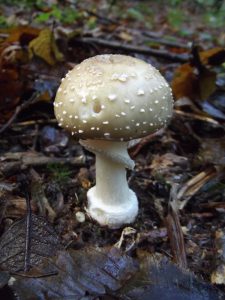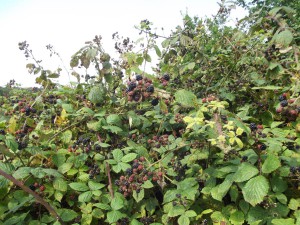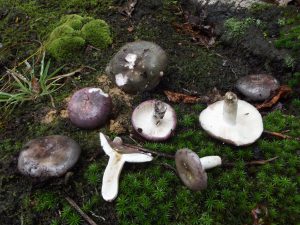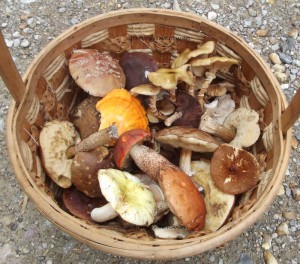25/08/2013
The mushroom season sometimes starts slowly, and sometimes bursts into life in a flash. The main action can start any time between the end of August and the start of October, but 2013 is shaping up to be a good one and an early starter. I held my first public session of the year yesterday afternoon (in Kent), and the results were very promising for such an early date. It was also very wet, which isn’t so brilliant from a picking point of view, but bodes well for the immediate future: yesterday’s deluge is likely to be the starting pistol for the bulk of the autumn species.
We did not find a vast selection of different groups of fungi. Instead there was a useful selection of many different species belonging to two groups: russula and amanita. This is actually quite helpful from a learning point of view, because it allows people to familiarise themselves with a particular subset of fungi rather than being overwhelmed with all sorts of unrelated and very different types. There were large amounts of one good edible species belonging to each group. We also found a nice selection of other edible bits and pieces, including chicken of the woods (Laetiporus sulphureus), pale oysters (Pleurotus pulmonarius) and common inkcaps (Coprinellus atramentaria). The good edible russula that turned up in quantity was the charcoal burner (Russula cyanoxantha), but since my last post was partly about an edible russula, I will dedicate this one to the other group.
![The Blusher ([em]Amanita rubescens[/em])](https://www.geoffdann.co.uk/wp-content/uploads/2013/08/blusherblog-247x300.jpg)
The Blusher (Amanita rubescens)
Amanita is not a genus for foraging beginners. It contains the two deadliest species in the world (the death cap (A. phalloides) and destroying angel (A. virosa)), as well as the infamous, but beautiful and enchanting fly agaric (A. muscaria), which is both hallucinogenic and nauseating. The good edible amanita we found large numbers of yesterday is a close relative of the fly agaric. It is called “the blusher”, and it’s a substantial, common and very tasty fungus. It also contains toxins, but they are broken down by cooking. All parts of the mushroom must be heated to above 80 degrees for this to happen. I find this puts some people off, but it’s really no different to cooking chicken. The picture on the left wasn’t taken yesterday, but last week in southern Scotland on my way back down to Sussex, of blushers growing in the grounds of a service station by the M74 motorway. The name refers to the tendency of this mushroom to turn slowly pink, especially when the flesh is exposed to the air. This is one of the important distinguishing features, which is very important if you are thinking of eating it, because this species is all too easily mixed up with several other members of its genus, one of which is particularly similar and particularly nasty.

Panthercap (Amanita pantherina)
And right on cue, the nasty lookalike appeared in the middle of yesterday’s session in Kent. The panther cap (Amanita pantherina) is another close relative of the fly agaric and blusher, and it contains similar toxins to the former, except considerably more of them. Panther caps are right on the border of being fatally poisonous – eat one or two and you are probably just going to have a very unpleasant experience, eat an unhealthy plateful of them and you might just die.
So how do you tell them apart? Panthercaps (left) do not “blush” like the blusher, and have more spiky and pronounced veil-remnants (spots) on the cap, and these are white rather than pinky-grey. They also have a different sort of stem base – the blusher has a bulb (volva) which merges neatly into the stem, whereas the panther cap has a “step” or rim around what is left of the volva. My advice is to do what I did: do not collect blushers for the pot until you’ve found and identified a panther cap.

Blackberries fruiting in profusion, end of August 2013.
Having had such a successful day yesterday, I decided to go out early this afternoon in the sunshine and explore some local bits of countryside in my new home town of Hastings. I ended up not quite where I intended to go, walking out on a wooden walkway that led to a viewing platform (a dead end) in the middle of a very large reed bed. On my way back to the woodland I’d intended to visit, I stumbled upon enough blackberries to keep me busy for the whole afternoon. It seems 2013 is going to be a bumper year for certain types of fruit. It is reportedly the best year in several for apples (and the tree at the bottom of my garden would appear to confirm this), and if this lot is anything to go by then it is also going to be a storming year for blackberries.
Watch out for those mushrooms – it is all about to kick off.
Geoff
 The last couple of days have seen another generous helping of rain in south-east England, and the first clear evidence that the fungi are back. And in fact the omens are positive, and right now I’d tentatively guess we’re in for a good autumn as far as fungi are concerned. This afternoon I visited a location I’ll be running some new events at this autumn. Details are available via the link at the top of this page, the area is called “Mill Wood”, and it is the site of a woodland pig farm that has been reclaimed by nature for the last four years, plus some adjacent land. We found plenty of Brittlegills (mainly Charcoal Burners), a Blusher, some boletes, a couple of very young Chicken of the Woods, a large flush of Common Puffballs just coming through and a lot of White-laced Shanks (all edible). There were also a few other, inedible bits a pieces. That’s not bad at all for August 13th after an extended spell of extremely hot and dry weather.
The last couple of days have seen another generous helping of rain in south-east England, and the first clear evidence that the fungi are back. And in fact the omens are positive, and right now I’d tentatively guess we’re in for a good autumn as far as fungi are concerned. This afternoon I visited a location I’ll be running some new events at this autumn. Details are available via the link at the top of this page, the area is called “Mill Wood”, and it is the site of a woodland pig farm that has been reclaimed by nature for the last four years, plus some adjacent land. We found plenty of Brittlegills (mainly Charcoal Burners), a Blusher, some boletes, a couple of very young Chicken of the Woods, a large flush of Common Puffballs just coming through and a lot of White-laced Shanks (all edible). There were also a few other, inedible bits a pieces. That’s not bad at all for August 13th after an extended spell of extremely hot and dry weather.

![The Blusher ([em]Amanita rubescens[/em])](https://www.geoffdann.co.uk/wp-content/uploads/2013/08/blusherblog-247x300.jpg)

